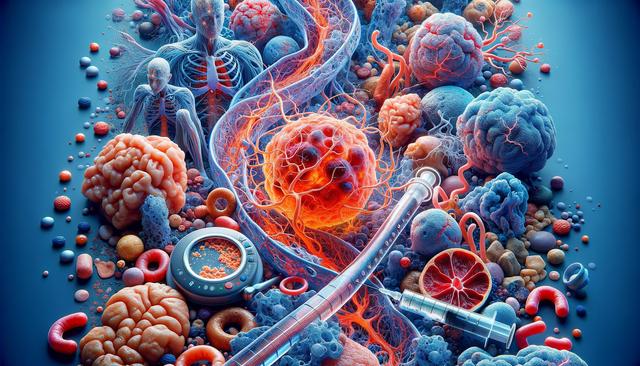What Is Amyloidosis?
Amyloidosis refers to a group of diseases characterized by the accumulation of amyloid proteins in various tissues and organs. These proteins are misfolded, meaning they do not assume their normal shape, and as a result, they clump together and form deposits. Over time, these deposits interfere with normal function, leading to symptoms and complications that vary based on the organs involved. Amyloidosis is not a single disease but a category of conditions, with several types classified by the type of amyloid protein involved. The most common types include AL (light chain), AA (secondary), and ATTR (transthyretin-related) amyloidosis.
While amyloidosis is rare, it is potentially life-threatening and often challenging to diagnose. Its symptoms can mimic those of other conditions, which can delay proper identification and treatment. The condition can affect the heart, kidneys, liver, spleen, nervous system, and digestive tract. Early detection is crucial, as it can significantly impact the effectiveness of treatment and patient outcomes.
Causes and Risk Factors
The causes of amyloidosis depend on its type. AL amyloidosis, the most frequent form, is caused by abnormal plasma cells in the bone marrow that produce defective light chain proteins. These proteins misfold and form amyloid deposits. AA amyloidosis, on the other hand, is usually a complication of chronic inflammatory conditions like rheumatoid arthritis or chronic infections. ATTR amyloidosis can be hereditary or age-related and involves a protein produced in the liver called transthyretin.
Risk factors for amyloidosis include:
- Age – Most types are more common in individuals over 60.
- Gender – Some forms, like AL amyloidosis, are more prevalent in men.
- Family history – Hereditary ATTR amyloidosis runs in families.
- Chronic inflammatory diseases – Increase the risk of AA amyloidosis.
- Kidney dialysis – Long-term dialysis may lead to a unique type of amyloidosis.
Understanding these risk factors can help individuals and healthcare providers remain vigilant, particularly in patients with underlying conditions that predispose them to amyloid buildup.
Symptoms and Diagnosis
Symptoms of amyloidosis vary widely depending on the organs affected. In many cases, they develop gradually and worsen over time. Common symptoms include:
- Unexplained weight loss
- Fatigue and weakness
- Swelling in the legs or ankles
- Shortness of breath
- Numbness or tingling in the hands or feet
- Changes in skin color or texture
- Enlarged tongue (macroglossia)
Because these symptoms are non-specific, diagnosis often requires a combination of tests. Blood and urine tests can detect abnormal proteins, while imaging studies help assess organ function. A definitive diagnosis typically involves a tissue biopsy, where a small sample from an affected organ or fat pad is examined for amyloid deposits using special staining techniques.
Treatment Options
Treatment for amyloidosis aims to reduce the production of amyloid proteins and manage the symptoms caused by organ damage. It varies depending on the type and severity of the disease. For AL amyloidosis, treatments often include chemotherapy to target the abnormal plasma cells and reduce the production of amyloid-forming proteins. In some cases, stem cell transplantation may be considered.
For AA amyloidosis, managing the underlying inflammatory condition is the primary approach. This might involve anti-inflammatory medications or antibiotics, depending on the source of inflammation. In ATTR amyloidosis, treatment options include medications that stabilize the transthyretin protein or reduce its production. Liver transplantation may be an option for hereditary ATTR cases.
Supportive care is essential and may include:
- Diuretics for fluid retention
- Medications to manage heart failure or kidney function
- Physical therapy for mobility issues
- Nutritional support to maintain weight and energy
Because amyloidosis is a complex disease, treatment often involves a multidisciplinary team of specialists working together to tailor plans to individual patient needs.
Living with Amyloidosis
Living with amyloidosis presents unique challenges, but many individuals can manage their condition effectively with proper care. Regular monitoring and follow-up are crucial to assess disease progression and adjust treatments as needed. Patients are encouraged to maintain open communication with their healthcare team and report any new or worsening symptoms promptly.
Adapting to life with amyloidosis may also involve lifestyle changes, such as:
- Eating a balanced, low-sodium diet to support heart and kidney health
- Engaging in light physical activity to maintain strength and energy
- Managing stress through mindfulness or counseling
- Joining support groups for emotional and informational support
Additionally, staying informed about the disease can help patients and caregivers make empowered decisions. Organizations dedicated to amyloidosis research and support often provide educational materials, patient forums, and updates on clinical trials. While the journey with amyloidosis can be complex, many people find strength and stability through proactive management and community support.
Conclusion
Amyloidosis may be rare, but understanding it is essential for early intervention and effective care. With various types impacting different organs and systems, diagnosis and treatment require a personalized approach. Staying informed about symptoms, risk factors, and available therapies can make a significant difference in outcomes. For individuals living with this condition, coordinated medical care and proactive lifestyle choices offer the foundation for improved quality of life and long-term management.




Leave a Reply